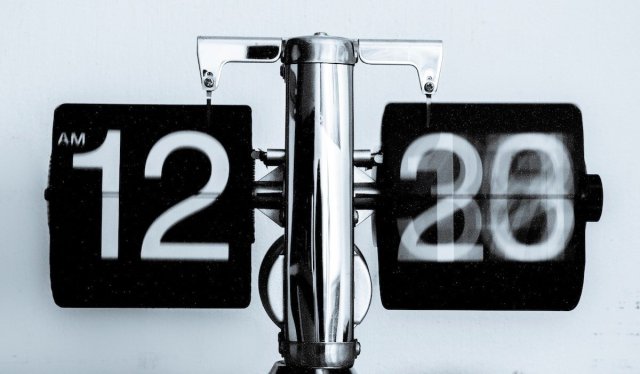The best time management strategies for scheduling your day, week, month, year, and even life
What’s the best time management strategy out there? Unfortunately, anyone who tells you they have the answer to that question is lying.
The truth is there’s no single time management system that works for every single person. They all have their strengths and weaknesses and their results will vary depending on your circumstances, goals, and personality.
If you’re anything like me, you’ll find the time management strategy that works best for you is actually a combination of different ones.
To help you find the elements of your ideal plan, we’ve gone through the most popular time management strategies out there so you can find the tips and tricks that work for your individual needs.
The best time management strategies for however you want to plan your time

By the hour
Who it’s for: The chronic procrastinator.
Why it works: If you’ve ever said ‘I’ll do it later’ then wondered why it never gets done, planning your next hour could be the kick you need.
Rather than getting overwhelmed and worrying about the big picture, these time management strategies will help you tackle your to-do list in small manageable chunks. Scheduling your time by the hour can also give you the most bang for your buck, taking very little effort to implement but providing real results.
The Pomodoro Method
What: The Pomodoro method is named after the small, tomato-shaped kitchen timer that only goes up to 25 minutes. The idea is simple: Rather than trying to work flat-out, break down your day into a series of work-sprints with a short rest period after each session.
How: Set a timer for 25min and focus exclusively on your work for that time. Once the time’s up, take a break for 5min. Repeat as necessary, with a longer break after every four cycles.
Pros:
- Simple to understand and implement
- Breaks down long complex tasks into a series of manageable sprints
- Suits even the most easily distracted
Cons:
- Some find taking a 5min break destroys their flow.
- Not ideal if your work involves frequent interruptions.
The 2-minute rule
What: Part of the Getting Things Done (GTD) methodology, the 2-minute rule is a strategy for quickly assessing and taking action on small tasks so they don’t take up too much mental energy.
How: When you’re putting your to-do list or going through your inbox, ask yourself if a task is going to take you 2 minutes or fewer. If so, don’t try to process or categorize the task—just get on and actually do it!
Pros:
- Prevents wasting mental energy on tiny tasks
- Less time planning and more time doing
Cons:
- Hard to accurately know which tasks will take just 2 minutes
- Great for tackling <2min tasks, but you’re going to need additional strategies for handling anything else.
The Next Hour
What: Created by time-management expert Mark Forster, this method involves literally planning out each of your next hours, rather than your whole day.
How: Start the day by writing a list of what you intend to do over the next hour. Regularly top up the list throughout the day so it always contains approximately one hour’s work.
Pros:
- Easier to accurately estimate how much we can do in an hour (compared to a day).
- Ideal for those with unpredictable circumstances.
Cons:
- Requires updating your ‘hourly’ list throughout the day.
- Can potentially use up more time planning than implementing. (Also, thanks to the Planning Fallacy, we have to be careful about not being overly optimistic about how long a task will take to complete).
By the day

Who it’s for: The over-promiser.
Why it works: Have you ever wondered how you’re going to fit everything on your to-do list in, without working 24 hours? We have a tendency to overestimate how much we can do in a day, which makes it easy to get stressed when we look back at the end of the day and wonder where it all went.
For best results, plan your day the night before; otherwise, the day has a habit of starting without you.
Time blocking
What: Assign every hour (or minute, if you’re feeling brave) of your day to a specific task.
How: Take your day’s to-do list and estimate how long each task will take, then plan your day out by assigning each task to your calendar. Include all related tasks (such as commuting, breaks and admin tasks).
Pro-tip: Assume every task will take twice as long as you expect. If you get it done quicker, congratulations—you’re ahead. However, when problems inevitably delay you, you’re still on schedule.
Pros:
- Removes decision fatigue and emotionally separate yourself from the work by planning ahead: If 9am-10am has already been assigned to a set task, follow that ‘order.’
- By scheduling a task to a specific time-frame, you can also take advantage of Parkinson’s law (if you’ve scheduled an hour to do your invoicing, it’s less likely to take up the whole day)
- Productivity expert Cal Newport estimates a 40 hour time-blocked work week produces the same amount of output as an unstructured 60+ hour work week
Cons:
- Unexpected disruptions make it impossible to accurately schedule a whole day
- GTD enthusiasts will recoil at the idea of using your calendar for anything other than specific date-based commitments
Eating the frog
What: Popularised by Brian Tracy’s book, eating the frog means taking the biggest, nastiest job you need to do and tackling it at the very start of the day, getting it over and done with.
How: Check out your to-do list. You know that task you’ve been putting off, the one that fills you with dread? That’s now your first task of the day.
Pros:
- Getting your win in for the day early sets you up for the rest of the day
- If you get nothing else done, the day has still been a success
Cons:
- It’s eating a frog—if the task is particularly nasty, you might still put it off and sabotage your whole day.
- Just because something’s a frog task, doesn’t mean it’s always a priority, logically or emotionally.
Natural energy cycles
What: Our energy goes through peaks and troughs during the day, so why not plan your day around them?
How: Identify when your peaks/troughs are (we wrote a guide on how to do that here) and schedule your day accordingly. You can also work with your chronotype to make sure you’re doing the right tasks at the right time. Here’s a basic rundown of the four chronotypes:
- Bears are active in the day, but they’ll likely hit the snooze button before they get up. They’re best tackling intensive tasks just before noon.
- Lions are early risers and are most productive in the morning, but are more likely to suffer an afternoon slump.
- Wolves would prefer to sleep through the morning. They peak late morning and late evening.
- Dolphins are light sleepers, and more likely to suffer from insomnia. They should save intensive tasks for later in the day and are most productive in sprints (rather than marathons).
Pros:
- Going with the flow rather than overdosing on caffeine makes your job a helluva lot easier
- Can schedule mentally demanding tasks when you’re at your best (and monotonous ones when your energy is naturally lower)
Cons:
- May take experimentation/time to identify your type
- Your day/job may not respect your cycle
Big rocks first
What: Imagine you want to fill a jar with big stones, gravel, and sand. If you put all the sand and gravel in first, you won’t fit the rocks in. By putting the big rocks in first, however, you can fill the sand around.
How: The big rocks method, as popularised by Steven Covey, means identifying your big rocks (i.e. your priorities) then planning your day around them. That means less important activities (your gravel and sand) take second place.
There are plenty of other methods that use a similar principle, such as:
- The 5-minute journal encourages people to ask “What would make today great?” to help people focus on their priorities.
- In their book, Make Time, John Zeratsky and Jake Knapp encourage people to define their daily highlight—your most important task that, if completed, means the day was successful.
- Tim Ferris recommends a similar method combined with time blocking in his post on productivity tricks for the neurotic, manic-depressive and crazy.
Pros:
- Know the most important tasks are taken care of, while still fitting secondary tasks in around them.
Cons:
- It’s a pretty picture, but life is rarely that simple. I don’t know about you, but my jar seems to have a leak, and all the stones are massive weird shapes.
- A good reminder to prioritize, but mileage may vary in the real world.
- Additionally, the illustration can promote the idea you have to keep your ‘jar’ as full as possible, with no leftover space and no breathing room, eventually leading to burnout.
By the week
Who it’s for: The constantly over-committed.
Why it works: Struggling to get everything into a single daily cycle? For some of us, there’s just too much to fit in just one day (meaning no two days are the same). If that’s the case for you, then planning your week with the following strategy may help.
Theme days
What: Theming each individual day of your week to a specific type of task.
How: Break your work into five (or fewer) categories, then decide which days will have which theme. Ideally, a day will only have one theme (but you might end up having more than one day to a theme).
For example, a freelancer might theme their days like this:
- Mon: Research
- Tues: Client work
- Wed: Marketing
- Thurs: Client work
- Fri: Bookkeeping.
While this will likely be a struggle for the traditionally employed, it might still be possible to theme part of your day (your mornings, for example). Set recurring reminders in your calendar for each day to help build the habit. If you’re still struggling, Entrepreneurs on Fire has a podcast episode to help you get started.
Pros:
- Avoid the productivity hit associated with multi-tasking or task-switching and instead focus 100% on a set task throughout the day
- You can also theme your days according to your weekly energy levels (if you struggle with Monday or feel exhausted by Friday, save easier tasks for those days)
Cons:
- Difficult when other people (employees/clients) have other ideas about what you should do with your time
- Doesn’t account for your energy cycle throughout the day (see above)
By the month

Interestingly, there aren’t many productivity strategies that revolve around monthly planning.
In fact, everything I found on monthly planning was about using it as a tool to keep track of your progress in other time management strategies. Monthly planning seems to be the middle ground of productivity planning: not quite short enough to track short-term goals, but not long enough to cover the big picture plans.
However, that doesn’t mean you should automatically neglect it. Catherine Beard of The Blissful Mind finds monthly planning a key part of her productivity:
“When you have a plan for the month, it gives you a sense of what you can realistically get done. By planning ahead of time, you can space out what needs to get done without feeling rushed. After all, if you try to work on too many projects in the same week, it’s only going to overwhelm you.”
Experiment with monthly planning and see whether or not it fits in with your productivity cycles.
By the quarter
Who it’s for: The big dreamer.
Why it works: It’s hard to have a big picture if you’re constantly grinding out work on a daily, weekly, or even monthly basis. By planning your quarters, you can start making progress on (or even complete) your long-term goals.
The 12 week year
What: Based on the book The 12 Week Year, the idea is to forget about your annual plan and accomplish the same goals in just 12 weeks.
How: When you’re planning for a year, December seems a long way off. The authors argue this leads to a lax attitude throughout the start of the year, leading to a burst of frantic activity as the end of the year gets closer.
Rather than divide your year into quarters, this is about setting big goals for the quarter, then taking consistent daily action to reach those goals.
Pros:
- When you have just 12 weeks to reach your goals, every day counts
- Encourages you to think in terms of what you can accomplish in less time
- Promotes daily action to accomplish long-term goals
- Committing to projects for a quarter makes it easier to pursue your passions, as explained by Sean McCabe in this podcast episode
Cons:
- Once you start thinking in quarters, the amount of effort and planning required increases dramatically (compared to your daily to-do list)
- Doesn’t leave much time for rest and reflection.
RescueTime helps you stay focused by blocking distracting sites, giving you in-depth reports on how you spend your time, and more. Try it for free.
By the year

Who it’s for: The seasonal worker.
Why it works: Not all months are created equal (at least for some jobs). Demand for your services may vary throughout the year, and you may have significant commitments both personal (that wedding coming up) and professional (those tax returns).
Planning out your year
What: Ready to take your energy cycles to the next level? Plan out your upcoming year to maximize your productivity.
How: Make a list of your annual commitments including work events (in my past life this meant annual reviews for various departments, as well as third-party inspections) and personal events (planned holidays, family visits and school holidays).
Plan your tasks around these events—moving them around if possible—so you don’t end up overloaded at any point. If your work is related to the weather in any way, or you suffer from seasonal affective disorder (SAD), you’ll also want to take this into account.
Pros:
- Most of us already do this subconsciously, so may only take a little extra effort to get substantially better results
- Planning your work throughout the year helps avoid panicked last-minute preparation
Cons:
- I don’t know what’s happening next week; how am I meant to plan a whole year ahead? This works best when used alongside short-term planning strategies to manage the necessary day-to-day activities
The Tickler File (AKA 43 folders)
What: Another strategy popularized by GTD, the Tickler file is a physical reminder system for your year.
How: Collect 43 folders (31 for representing days of the month, 12 representing the months) and organize them into the following order:
- Today’s folder at the front
- The remaining days of the month
- Next month’s folder
- The remaining months of the year
- The (emptied) current month
- The days you’ve already gone through
Keep reminders in the relevant folders. For example, if you have an appointment in November, put the appointment slip in the November folder. As you start each month, move the reminders from the month folder to the relevant day folder. Then, at the end of each day, move that folder to the back.
(For more detailed guidelines, Lifehack has a great guide to help you get started.)
Pros:
- Great for physical reminders and keeping paper out of your intray
Cons:
- If you can live with using your calendar as a reminder system, a Tickler file seems largely redundant, especially in the digital age
By the lifetime

Who it’s for: The Visionary.
Why it works: Do you want to leave your mark? Have you set yourself a mission that will change the world? Then keeping your lifetime goals at the center of everything you do might be the key to success.
The masterplan
What: Time for some top-level thinking. What were you put on this planet to do? Ignore specific timelines and instead focus on progressing toward your key goals.
How: Rather than planning your time, plan your goals. Keep them as your key focus, then evaluate your time and actions with one simple question: Will this action get me closer to my goal, or not?
This might go against your short-term motivations. For example, if you want to be President, you might choose to volunteer for local political activities, as opposed to taking a high-paying job in the private sector.
Pros:
- Keeps sight of your lifetime goals and encourages regular progress on the things that really matter
- Stops you from taking actions that only benefit you short-term
Cons:
- Focusing on the goal without identifying your pathway may mean you get lost along the way
- Sometimes a focus on minutiae is needed to get you to your goals
So, which of these time management strategies is right for you?
There’s no limit to time-scheduling systems out there, and each one has some value for the right person.
However, trying to find the one system that you’ll use for the rest of your life is unlikely, if not impossible, to work. The best results come from a pick-and-mix approach, using a combination of methods.
That’s the reason I highlighted two individual strategies from the GTD system. While I’m sure David Allen is right and they work best as part of one all-encompassing system, I’m not good at sticking to a strict system.
In my personal experience, the best methods come from a combination of long-term and short-term thinking.
What works for you? Have I missed out any time-structured systems? Share your favorites in the comments.